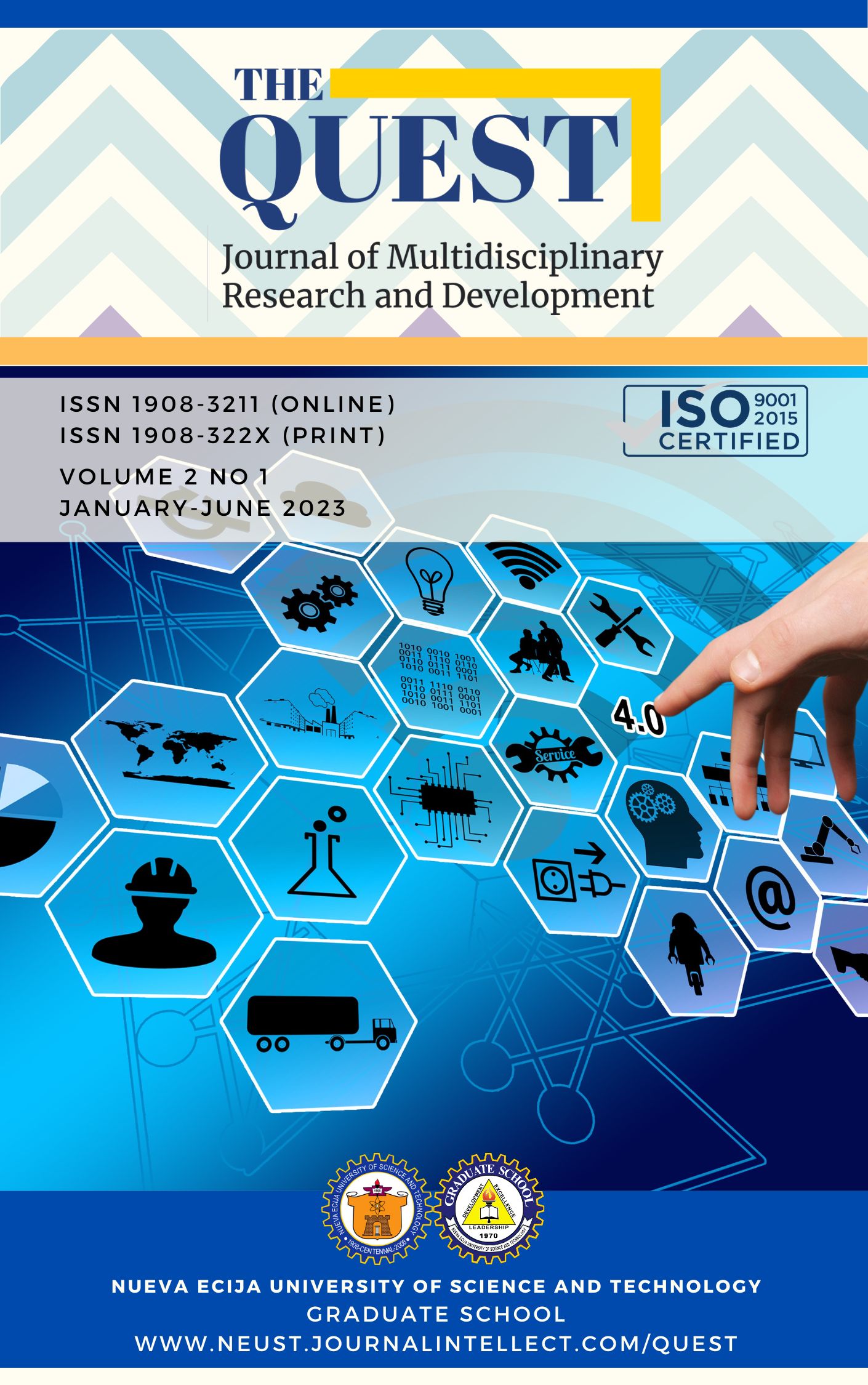E-Module in Teaching Statistical Methods: An Asynchronous and Synchronous Delivery Mode Under the New Normal

Published 06/30/2023
Keywords
- Office Mix; E-module; Statistics; Asynchronous; Synchronous;
How to Cite
Copyright (c) 2023 The QUEST: Journal of Multidisciplinary Research and Development

This work is licensed under a Creative Commons Attribution-NonCommercial 4.0 International License.
Abstract
The study entitled E-module in teaching statistical methods: an asynchronous and synchronous delivery mode under new normal focused on the development and assessment of the e-module created using office mix. The e-module was developed with powerpoint presentation for each of the eight (8) lessons in statistics having audio or video explanation of the topics per slide exported as video presentation were shared by the researcher to the mathematics experts, IT experts and students for evaluation. The research adopted the ADDIE model from the analysis of the students that led in realizing the study up to the implementation and evaluation. Each of the lessons in the e-module was designed and developed based on the needs of the students.
The research findings of the mathematics experts, IT experts, and students favored the e-module as it was proven very acceptable and therefore highly recommended for use. In terms of the objectives, content, motivational or review activities, delivery of instruction, and formative assessment exercises evaluated by the mathematics experts, the grand mean was 3.62 indicating the e-module was really having acceptable standards. While the evaluation of the ICT experts revealed a grand mean of 3.77 indicating that the content, layout, design, usability and quality of the e-module are very acceptable and highly recommended for use. The students’ evaluation obtained a grand mean of 3.74 numerical description and interpretation that the content, layout, delivery of instruction, instructional use, and formative assessment exercises are also very acceptable and highly recommended for use. The evaluation of the students also resulted to the positive feedback while exploring and using the e-module that provided them with notable experiences about the office mix.
References
- Abubakar, B.M., & Hassan, B. (2013). Strategies for Developing an e-Learning Curriculum for Library and Information Sciences (LIS) Schools in the Muslim World: Meetig Expectations in the Digital Age. https://www.semanticscholar.org/paper/Strategies-for-Developing-an-e-Learning-Curriculum-Abubakar-Hassan/755a8baffe31d4fc089c937992d6c040787011f7
- Ahmed, R., Seedat, M., Van Niekerk, A., & Bulbulia, S. (2004). Discerning community resilience in disadvantaged communities in the context of violence and injury prevention. South African Journal of Psychology. 2004;34(3):386–408.
- Albano, G. (2012). Mathematics education: Teaching and learning opportunities in blended learning (pp. 60-68). Retrieved July 3, 2014, from http://www.igi-global.com/chapter /mathematics-education-teaching-learning opportunities/57934?camid=4v1
- Allcock, S. and Hulme, J. (2010) Learning styles in the classroom: Educational benefic or planning exercise? Psychology Teaching Review, 16 (2), 67-79. Retrieved from ERIC database (EJ920100).
- Al-Rukaibawi, I.S. (2015). Office Mix in Education: An Interactive Approach to Flip Teaching in the Classroom. Retrieved from Research Gate: htttp https://www.researchgate.net/publication/280599637_Office_Mix_in_Education_An_Interactive_Approach_to_Flip_Teaching_in_the_Classroom
- Ambler, M. (2003). Putting a name to Cultural resilience. Tribal College Journal. 2003;14(4):8–9.
- Andersson, N., Ledogar, RJ. (2008). The CIET Aboriginal youth resilience studies: 14 years of capacity building and methods development in Canada. Pimatisiwin: Journal of Aboriginal and Indigenous Community Health. 2008;6(2):65–88.
- Anttila, M., Valimaki, M., Hatonen, H., Luukkaala, T., & Kaila M. (2012). Use of web-based patient education sessions on psychiatric wards. International Journal of Medical Informatics, 81(6), 424- 433.
- Ayanda, D., Eludiora, S., Amassoma, D., & Ashiru, M. (2011). Towards a model of e-learning in Nigeria higher institutions: An evolutionary software modelling approach. Information and Knowledge Management, 1(1), 31-39. Retrieved May 9, 2014, from http://www.iiste.org
- Banditvilai, C. (2016). Enhancing Students' Language Skills through Blended Learning Electronic Journal of e-Learning, v14 n3 p220-229 2016. https://eric.ed.gov/?id=EJ1107134
- Bennison, A. and Goos, M. (2010) 'Learning to teach mathematics with technology: A survey of professional development needs, experiences and impacts', Mathematics Education Research Journal, vol. 22, no. 1, pp. 31–56.
- Bennett-Levy, J., Hawkins, R., Perry, H., Cromarty, P. and Mills, J. (2012) 'Online cognitive behavioural therapy training for therapists: Outcomes, acceptability, and impact of support', Australian Psychologist, vol. 47, no. 3, pp. 174–182.
- Besar, D. S. (2018) Situated Learning Theory: The Key to Effective Classroom Teaching? Retrieved from: https://www.researchgate.net/publication/327530821_
- Situated_Learning_Theory: The_Key_to_Effective_Classroom_Teaching
- Chickering, A. W. & Ehrmann, S. C. (1996, October) cited in 2014. ‘Implementing the seven principles: technology as lever’, AAHE Bulletin, vol. 49, no. 2, pp. 3–6. https://journal.alt.ac.uk/index.php/rlt/article/view/2319
- Coleman (2020). Child and Adolescent Psychiatry and Mental Health/ Published: 12 May 2020-https://capmh.biomedcentral.com/articles/10.1186/s13034-020-00329-3#Abs1
- Coppola, N. (2015). Becoming a Virtual Professor: Pedagogical Roles and Asynchronous Learning Networks. https://www.researchgate.net/publication/220591836_Becoming_a_Virtual_Professor_Pedagogical_Roles_and_Asynchronous_Learning_Networks
- Crow, C. (2020). Developing Resilience: Overcoming and Growing From Setbacks. https://www.mindtools.com/pages/article/resilience.htm
- Cullata, R. (2015). Situated learning. Retrieved from on October 6, 2015 from http://www.instructionaldesign.org/theories/situated-learning.html
- Culatta, R. (2020), & Forest, E. (2014). The ADDIE model: Instructional Design. Posted in Framework and Theories.ADDIE model Retrieved from: https://www.instructionaldesign.org/models/addie/
- Dawley, L. (2007). The tools for successful online teaching. London: Information Science Publishing.
- DEUCHAR, A. (2010). Opportunities for the development of critical thinking skills in the mathematics classroom. (Master's thesis) North-West University. Retrieved from: http://hdl.handle.net/10394/4823
- DepEd Order No. 8, s. 2015. "Policy guidelines on classroom assessment for the K to 12 basic education program". Retrieved from www.deped.gov.ph.
- DepEd Order No. 42, s. 2016. "Policy Guideline on Daily Lesson Preparation for the K to 12 Basic Education Program."
- DepEd MEMORANDUM DM-CI-2020-00162 https://depedmandaluyong.files.wordpress.com/2020/07/dm-ci-2020-00162_suggested-strategies-on-dldm-fy-2020-2021.pdf
- Department of Justice. (2020). Modern Day Slavery During COVID-19: Challenges, Priorities and Perspectives”. Retrieved from https://doj.gov.ph/news.html?title=Public%20Advisory&newsid=612
- Esteban, A. P. L. (2023). Anomaly Recognition in Wireless Ad-hoc Network by using Ant Colony Optimization and Deep Learning. International Journal on Recent and Innovation Trends in Computing and Communication, 11(5), 395–403. https://doi.org/10.17762/ijritcc.v11i5.6692
